Inorganic flexible electronic devices still use silicon and metal as the material system, replacing the rigid matrix of traditional electronic devices with a flexible substrate, and at the same time, the mechanical structure design of the extensible structure enables the silicon and metal materials inside the device to undergo overall deformation. It is still not destroyed, thus realizing the deformability of the electronic device. In the service process, flexible electronic devices often have to be dynamically attached to any non-developable surface (such as a human body surface). Therefore, their ability to be stretched is crucial (Figure 1). Stretchable flexible electronic devices generally consist of non-deformable functional components and extensible structures. In the past ten years, flexible electronic devices have been continuously innovated with extensible structural designs to meet different design requirements, from one-dimensional structures to two-dimensional and three-dimensional structures, from simple single-stage structures to multi-level fractal structures. These extensible structures can be divided into two categories: 1) Free structure. Its characteristic is that the structure does not bond with the matrix, the structure is not constrained by the matrix in the process of deformation, can be freely deformed, and has large ductility, but can not be encapsulated; 2) bonded structure. The characteristic is that the structure and the substrate are bonded together. During the deformation process, the structure is restrained by the substrate, the ductility is small (<60%), and the encapsulation layer has little effect on the ductility. In actual device applications, packaging is often required, and non-deformed functional components need to occupy a certain area fraction, and the actual device's ductility is often only about 10%. Therefore, flexible electronic devices have to be practically used, and it is urgent to study structural designs that can be packaged and have high ductility. Previously extensible structures were designed primarily as curved "film" structures (Fig. 2a), typically tens of micrometers in width and several hundred nanometers to 1 to 2 micrometers thick. In the case of overall tensile deformation, the structure undergoes wrinkling or deformation. Lateral flexion. Recently, the Flexible Structures and Devices Group of the Institute of Mechanics, Chinese Academy of Sciences collaborated with researchers from the University of Illinois at Urbana-Champaign and the United States Northwestern University to find new ways to propose a non-buckling design, that is, to increase the thickness of the wire to the same width as the width. Grades, numerical calculations and experimental tests have all shown that the ductility is greatly improved (Fig. 2b), and the optimized value can reach 350%, which is 6 times the maximum (60%) of the current membrane structure. At the same time, due to the increase in the thickness of the wire, its resistance is greatly reduced, providing good electrical and thermal properties for electronic devices. Due to its excellent mechanical, electrical and thermal properties, non-buckled structures are used in the development of three types of ductile flexible electronic devices: 1) Extended LED arrays. The pre-stretch configuration is shown in Figure 3a, and it still works after 245% stretch (Figure 3b). On the Other hand, relative to the thin film structure, its thickness increased resistance and heat generation was also greatly reduced. Compared with a structure with a thickness of 300 nm, the maximum temperature was reduced from 200 degrees to 80 degrees, demonstrating its good Thermal properties. 2) Extensible solar cells. Figure e shows the deformation of a solar cell based on a non-buckling structure. The stability of the cell does not change during the overall tensile strain increase from 0 to 110% (Figure 2f). 3) Extendable flexible antenna that can be used for skin electronic communication. This work related paper has recently been accepted by the international periodical "Advanced Materials" (Yewang Su, et al., In-Plane Deformation Mechanics for Highly Stretchable Electronics. Advanced Materials. Accepted). The research work was funded by the "100-person plan" project of the Chinese Academy of Sciences and the National Natural Science Foundation of China. FUXIBIO Ffp3 Respirator manufactured by Careable biotechnology Co.,Ltd Cup Shape With Valve Ffp3 Respirator Cup, Ffp3 Face Mask with Valve, Ffp3 3D Mask, Ffp3 Mask Online CAREABLE BIOTECHNOLOGY CO,. LTD , https://www.careablemask.com